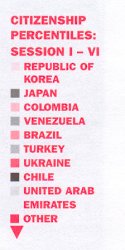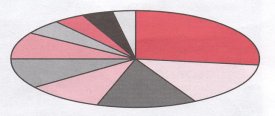ELI student demographics
Who studies at ELI? What countries are represented in a typical class? Two things all students have in common are their desire to master English and their choice of ELI as the place to accomplish that goal. Beyond these shared characteristics, the student population of ELI shines with the diverse colors of a constantly changing cultural rainbow. Men and women from differing backgrounds reflect a variety of goals and interests. The institute aims to maintain demographic diversity. This benefits the students directly by contributing to an optimum learning environment, and it also helps to maintain a stable enrollment for the smooth functioning of the program.
On the average, about 35 countries are represented during any given session. This mix varies with changes in student needs and international situations. Before the Asian economic crisis, for example, the number of Koreans studying at American intensive language programs was high, about 60% of the total student population in some schools and about 40% at ELI. After the crisis, the number of new Korean students at ELI dropped to zero, and the percentage of continuing Koreans gradually declined until this group accounted for only 6% of the total.
 |
As a result of recruiting efforts and other factors, the number of Latin American students began to increase at about the same time. Currently, the number of Asian students is rising again. The percentages for the 1998-99 year included 15% from the Republic of Korea and 13% from Japan. Another factor which accounts for the variation in student population from session to session is that special program groups from around the world come and go. For example, some of the recent special groups have visited from Brazil, Colombia, Japan, Korea, Thailand, Turkey, Ukraine and several African nations.
Over its history, ELI has experienced several major demographic shifts. The first groups of students, from Venezuela and Iran, needed language skills for their work in the oil industry. Later came substantial groups of Saudi Arabian and Malaysian students, followed by students from Japan and Korea. More recently, a large part of the ELI population has come from Latin America.
 |
In the beginning, most students had academic goals and were sponsored by special groups, businesses or semi-government agencies. Today ELI admits many more individual students, many of whom are making personal financial sacrifices for the opportunity to improve their language skills in the States. Between a third and a half now study in the business track, and a quarter are academically bound. The remainder is largely composed of university students who are taking a year off to study abroad and immerse themselves in American culture. In the early years of the Institute, the typical student was a young man (the average age in the 1980s was 19). Today students tend to be more mature with an average age of 24, and there is a more even mix of men and women, many of whom are professionals in their fields.
For the period September 1998 through August 1999, ELI enrolled 1,412 students in fifteen programs. In addition, it served 74 International Teaching Assistants from various UD departments and 132 Limited English Proficiency students in the Christina School District. The pie chart included with this article shows a breakdown of the nine most represented nationalities during this period. (Please note that these figures are based on total enrollment counts, rather than on individual students, i.e., those who enroll in a second session are counted twice.) The largest single category, marked "Other" at 27%, is composed of students from all around the globe, 46 countries in all. During the 1998-99 year, ELI had 55 countries represented in its program.
In today's competitive environment, students are seeking quality and value. To augment information received from placement agencies, many students research their options via the Internet. Potential students check out the ELI website and often e-mail questions before completing the admissions process. "Well-informed students are usually happier students who are better able to achieve their goals by taking full advantage of the learning opportunities offered," said ELI Director Scott Stevens. "We are pleased that so many outstanding scholars from around the world are choosing the English Language Institute."
| Return to Table of Contents |